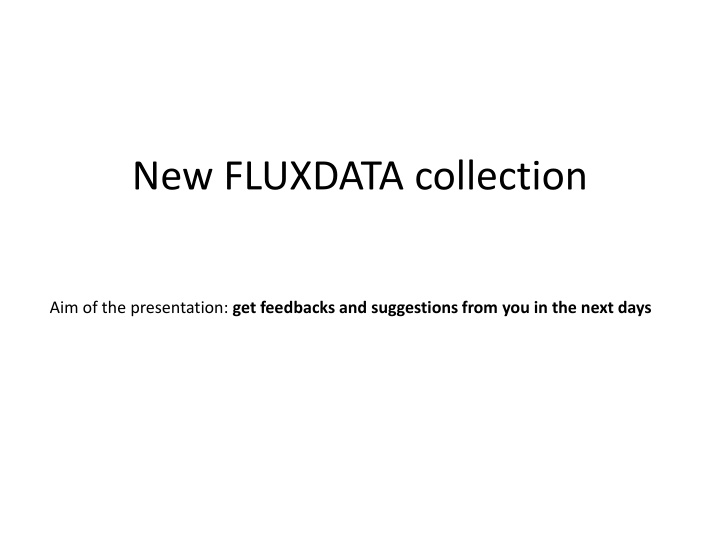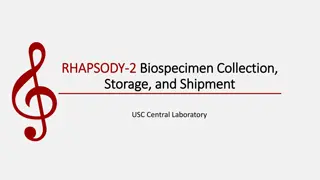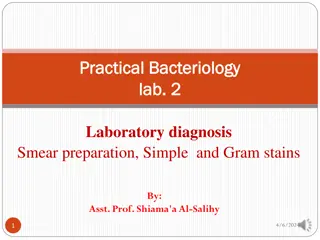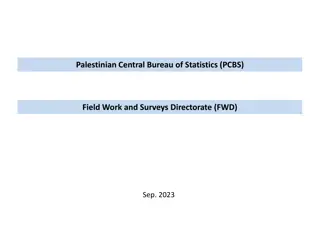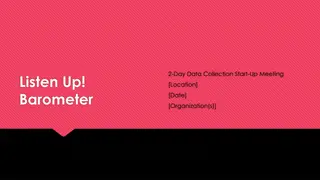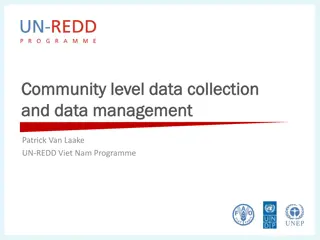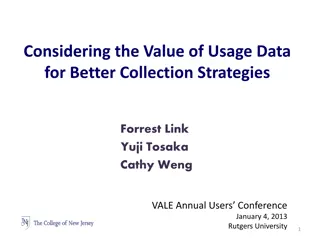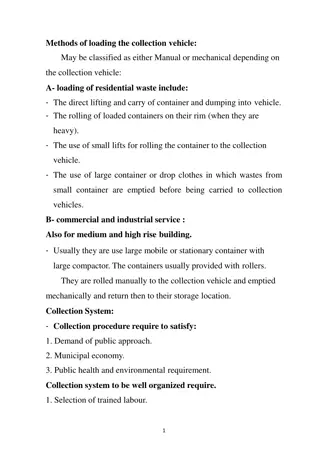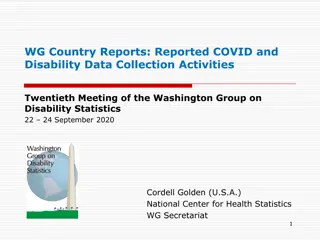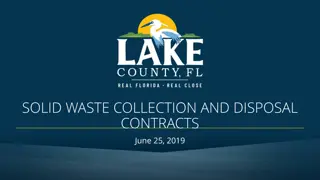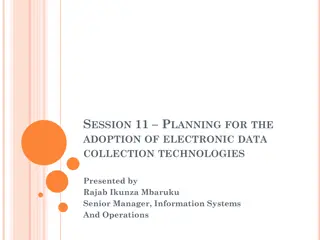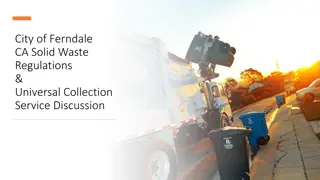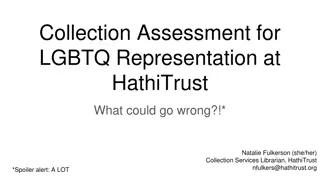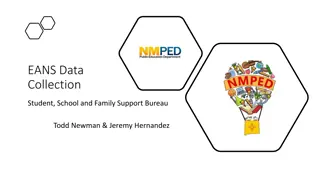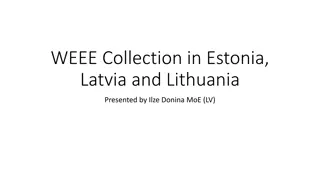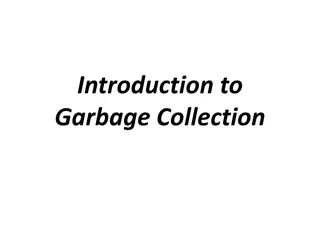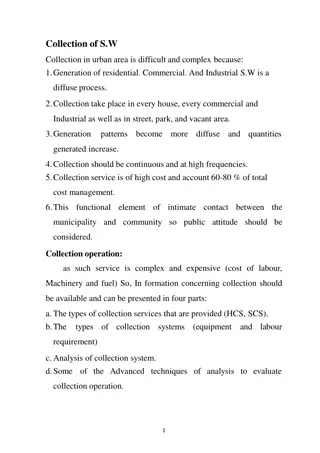New FLUXDATA Collection Overview
The presentation aims to gather feedback and suggestions for the upcoming collection. Insights from the LaThuile 2007 data collection are discussed, highlighting the importance of additional methods, PI versions, data sharing policies, ancillary data, filling regional gaps, and addressing uncertainties. The expansion includes new sites in various regions, with a focus on uncertainty quantification and Ustar threshold selection methods.
Download Presentation

Please find below an Image/Link to download the presentation.
The content on the website is provided AS IS for your information and personal use only. It may not be sold, licensed, or shared on other websites without obtaining consent from the author.If you encounter any issues during the download, it is possible that the publisher has removed the file from their server.
You are allowed to download the files provided on this website for personal or commercial use, subject to the condition that they are used lawfully. All files are the property of their respective owners.
The content on the website is provided AS IS for your information and personal use only. It may not be sold, licensed, or shared on other websites without obtaining consent from the author.
E N D
Presentation Transcript
New FLUXDATA collection Aim of the presentation: get feedbacks and suggestions from you in the next days
The LaThuile 2007 collection The LaThuile 2007 data collection gave a lot of visibility to FLUXNET and the eddy covariance technique in general. This visibility can be also useful to support the regional networks, critical for the FLUXNET success. A good number of synthesis papers based on the data collection have been published and a lot are under preparation. This scientific activity gave also the possibility to establish new collaborations and links between scientists and networks. However we also learned in these years what should be improved respect to the LaThuile 2007 collection in particular in the view of the new collection under preparation: - Additional methods should be used in the data processing - PI s version should be added if different from the others provided - Different data sharing positions between PIs exist, so different policies could be proposed in particular given the interest from external communities. - Ancillary data are important. Very important. - Gaps in some region should be filled - Uncertainty, uncertainty, uncertainty.
New sites in the next collection 83 US sites, 26 CA sites, 126 EU sites At least 7 African sites (5 new), 7 Japan (3 new), 9 Siberian (2 new), 2 Panama, Indonesia, India(?) Click image for full size FLUXNET Graphic
Uncertainty quantification Ustar and partitioning NEE, GPP, Reco Reichstein et al in prep. Ustar methods and uncertainty NEE Barr et al in prep.
Ustar threshold selection LaThuile 2007 method 2 1.6 M 1.2 flux x selected as threshold if flux(x) >= M x 0.99 0.8 0.4 x 0 0 0.1 0.2 0.3 0.4 0.5 0.6 0.7 0.8 ustar Reichstein et al. GCB 2005, Papale et al. BG 2006
Ustar threshold selection Modified version forward 2-points 2 1.6 M 1.2 x selected as threshold if: flux(x) >= M x 0.99 AND flux(x+1) >= M x 0.99 flux 0.8 0.4 x 0 0 0.1 0.2 0.3 0.4 0.5 0.6 0.7 0.8 ustar Reichstein et al. GCB 2005, Papale et al. BG 2006
Ustar threshold selection Modified version back 2-points 2 1.6 M 1.2 x selected as threshold if: flux(x) < M x 0.99 AND flux(x+1) < M x 0.99 flux 0.8 0.4 x 0 0 0.1 0.2 0.3 0.4 0.5 0.6 0.7 0.8 ustar Reichstein et al. GCB 2005, Papale et al. BG 2006
Ustar threshold selection Methods comparison Back 2 points Forward 2 points u* threshold New methods Original re-implemented u* threshold LaThuile 2007
Ustar threshold selection Change-point detection method Not Updated! Change-point det. Barr et al in prep. LaThuile 2007
Ustar threshold selection The different methods developed give in general higher threshold values respect to the LaThuile07. R2 =0.87 (y=11.47+1.00x, p=0.000, N=144) R2 =0.97 (y=-3.64+1.01x, p=0.000, N=144) 4000 4000 GPP from MR2005 [gC m-2 yr-1] TER from MR2005 [gC m-2 yr-1] VU-Coc 3000 BR-Sa1 3000 BR-Ma2 BR-Sa3 BR-Ji2 AU-Wac AT-Neu AU-Tum US-NC2 BR-Sa3 AT-Neu AU-Tum 2000 2000 US-Dk3 JP-Tef US-Goo JP-Tef However comparing night- time and day-time based partitioning (day-time almost influenced by u*) the agreement is high in most of the cases. 1000 1000 US-Dk3 IT-Lec BR-Sa2 BR-Sa2 IT-Lav IT-Lec methods 0 0 not 0 1000 2000 3000 4000 0 1000 2000 3000 4000 GPP from GL2009 [gC m-2 yr-1] TER from GL2009 [gC m-2 yr-1] 3000 R2 =0.79 (y=-15.99+0.90x, p=0.000, N=144) 1 Flux derived from MR2005 [gC m-2 yr-1] Climate zones 1 1 500 NEE from MR2005 [gC m-2 yr-1] 2000 AT-Neu US-Goo US-SP2 0 34 UK-PL3 5 4 4 FR-Lq2 3 5 3 5 BR-Sa3 US-SP3 1000 -500 BR-Ji2 IT-Lec 6 6 6 2 7 2 7 7 2 US-NC2 -1000 US-Dk3 34567 34567 34567 34567 34567 34567 34567 34567 34567 34567 2 2 2 2 2 2 2 2 2 2 0 1 1 1 1 1 1 1 1 1 1 -1500 IT-Lav -1000 -1000 0 1000 2000 3000 -1500 -1000 -500 0 500 Flux derived from GL2009 [gC m-2 yr-1] NEE from GL2009 [gC m-2 yr-1]
Gapfilling Methods comparison (MultiYear vs Single Year) Gapfilling is not the main source of uncertainty and the methods used (MDS and ANN) have been tested in the Moffat et al. 2007 comparison. Long problem, in particular if occur during phenological (spring). gaps remain a critical phases Artificial gap length Artificial gap length When multiple years are available, gapfilling model parameterization can use the information relations drivers-fluxes from others years. about Artificial gap length Artificial gap length Trotta et al in prep.
Data processing Half hourly data 1 dataset u* threshold selection - 3/5 different methods 3 methods, bootstraping 3/5 datasets Also daytime, also data after low turb., u* filtering - 3/4 possibility 9/20 datasets MDS and ANN Gapfilling - 2 methods Percentiles 18/40 datasets 1 5 25 50 75 95 99 Reichstein, Lasslop, van Gorsel Partitioning - 3 methods ? Frequency NEE Ok for the uncertainy, but we need also a referencevalue Between 54 and 120 different versions of the same dataset, all valid, it is uncertainty. What do we distribute? and using the median would affect the variability. Suggestion from you NEEDED!!
Meteo data QAQC and others feedbacks There are a lot of tests that can be implemented to identify potential problems with the meteo data that would lead to an accurate check. Examples are: - Check that the diffuse radiation is not greater than total radiation - Check that the relation between global incoming radiation and incoming PAR is stable in time - Check that below canopy PAR is not greater than incoming PAR - Check that after rain (> of a threshold) there is a change in SWC and the other way round - Check that the relations between air temperature and different soil temperatures are stable (monthly because phenology would affect this) Your contribution and ideas are fundamental. Antje Moffat created a site where you can suggest tests or comment proposed tests. http://fluxnet.betaboard.ca/f1-ideas-for-meteo-checks You should register, it if fast and easy, in this way we can better identify who proposed what. However, if the registration is the limiting factor for you, use my account: USER ID: fluxnet PASSWORD: meteo_tests
Ancillary data and metadata Ancillary data are very important and their availability would permit new studies and synthesis activities. At the moment these data are not available for most of the sites. In addition, information about the tower building, sensors setup, raw data processing, PI version of fluxes calculation methods, are important to correctly interpret the data. These info are sometimes collected at regional level using different formats and schemes and not continuously updated. The BADM is now an international standard, it is used also in EU projects and it will be used also in ICOS. A new version, with a different organization for an easier filling will be released soon. A metadata template, with the same BADM structure, has been prepared and it is under test. It will be used to transmit and register all the info about the site setup and data processing in a standard and structured way. First tests at some sites show that although at the beginning it looks a lot of work, it is not difficult and help to store info that otherwise would be lost. Do you remember all about your site?
Additional products Together with the processed fluxes and meteo data, the ancillary data and the metadata, a number of additional derived products will be released for each site. These could include for example: Derived variables (ecosystem parameters and climatic indices) Footprint calculation (Kljun model, but different inputs are needed) Long term daily meteorology at site level from ECMWF downscaling Time-scale separation of variables Solar time, Sun position, modelled diffuse radiation fraction Remote sensing products cutout Modis cutouts St ckli fPAR/LAI MERIS Parasol/Polder Meteorogical cutouts ECMWF WATCH SHEFFIELD NCEP Lat: 50 , Long: 0 Do you have codes ready? Mahecha et al. (2010), JGR-Biogeo
New data policies The community is quite heterogeneous in terms of data sharing and data use policy to be applied. For this reason three different data policies have been created: LaThuile policy: sharing only with data contributors - Data are shared only with others data contributors - Data access is possible only with a synthesis proposal accepted - It is mandatory to invite all the data contributors to give additional intellectual inputs to the paper and become coauthors Full policies texts available on www.fluxdata.org - Strict rules in terms of communications between paper leader and site Pis Different years of the same site can have different policies - Group coauthorship and site paper citation when possible. Opened policy: sharing openly but under control Login in the fluxdata.org system and do your selection for your sites - Data are shared also with external communities Today, 4PM-5PM, parallel session, we can do this together - Data access is possible only with a synthesis proposal accepted - Encuraged but not enforced to invite data contributors to give additional intellectual inputs. Mandatory if few sites or many ancillary data. - Group coauthorship and site paper citation when possible, Free Fair-use policy: simply sharing openly
New collection plan, how to contribute Deadline for new data submission passed and we are preparing the processing. However, due to the huge number of things to prepare (codes, data flow, new QC implementation etc.), there is still a last chance to send new data before we really start the processing. After we start it will not be possible to add data. The objective is to have the new data collection ready this year, possibly before summer. Fluxes and meteo data submission: Ameriflux sites and sites in US in general: Tom Boden Canadian sites: CCP database European sites and sites managed by EU institutions: Dario Papale African and Russian sites: Dario Papale All others sites: Bob Cook BADM and Metadata All sites directly to fluxdata.org Fluxes, meteo, BADM and metadata processing All sites will be processed by the fluxdata.org team between Europe and US
Conclusions The FLUXNET synthesis activity can give more and more visibility to our work and produce a lot of interesting scientific activities Data processing and standardization is fundamental, as pointed out in many reviews of papers submitted in the context of the LaThuile 2007 activity However it is important to improve the processing methods and to characterize the uncertainly in the data. In this activity the participation of the community is crucial. Please give your ideas and suggestions! Ancillary data are also crucial and large effort should be on these additional data collection, preparation and submission. Just as indication, about 75% of the ICOS Ecosystem sites will be dedicated to no-eddy-fluxes measurements. You are still in time to submit flux and meteo data due to our delay in the processing Looking forward to collaborate more and more with all you for a more and more visible, robust, productive and funny FLUXNET collaboration in the next years
